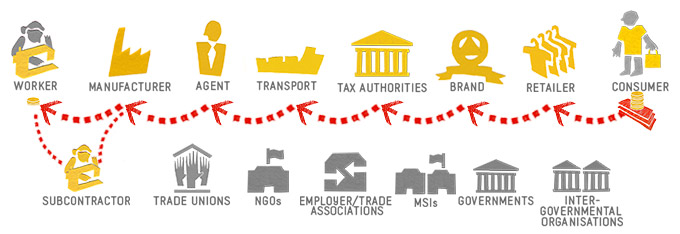Living wages: Obstacles and their solutions
It’s abundantly clear: Garment Workers need higher wages.
Most consumers want garments made by workers who are paid a living wage. Research shows that payment of living wages does not have to lead to much higher prices . In most cases, the relatively small cost increase could be absorbed by the profit margins of the brand. And many consumers are willing to pay a little bit extra to ensure their garments are made fairly.
So why are consumers unable to buy ‘living wage garments’? And what is happening in this market to block what seems like a pretty simple ask?
This is the question this portal – and FWF’s work on living wages more generally – sets out to address.
One answer is: it’s not a simple ask at all.
All along the supply chain, there are many obstacles to living wage implementation. And there are so many different types of supply chains, in so many different countries, that these obstacles also vary. So there is not one solution – there are many, and they work best combined.
Another issue: there is not one single actor – worker, factory, brand, government, consumer – who has the power to ‘just pay higher wages’. Collaboration is required, across actors, across countries and across markets.
And so it’s only natural that many say: we don’t know where to start!
To answer that question, we need to know two things.
First: what does a supply chain look like in which living wages are being paid? And second: what are the obstacles that are preventing current supply chains from looking like that?
The Living Wage Supply Chain
For FWF, the most effective and sustainable way to realise living wages is through mature systems of social dialogue [link to obstacle]. It is also the most resource- and cost-efficient in the long-term.
Essentially, social dialogue means that managers and workers truly own the wage setting process together. It requires workers who are in a position to speak up; worker representatives and trade unions who can do their work freely; and employers and employer associations who are willing to communicate with workers openly – and have the economic position to raise prices in accordance with the necessary rise in wages.
Obstacles
To achieve lasting progress on living wages, we need to keep working methodically to lay the foundations for effective social dialogue. At the same time, FWF’s work and analysis also focuses on other factors in garment supply chain that are impeding living wages – and each of which is either directly or indirectly blocking effective social dialogue to increase wages [link to article on link between SD and wages?]. In other words: without addressing some of the deeply rooted industry practices that are contributing to current low wage levels, effective social dialogue between empowered social partners will remain elusive.
Here’s an overview of the obstacles to living wage implementation we’ve identified so far. By clicking on any of them, you’ll be directed to the articles in this portal that discuss possible solutions.


